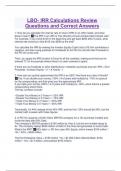LBO- IRR Calculations Review
Questions and Correct Answers
1. How do you calculate the internal rate of return (IRR) in an LBO model, and what
does it mean? ✅The IRR in an LBO is "the effective annual compounded interest rate":
For example, if you invest $100 in the beginning and get back $200 after 5 years, what
interest rate would turn that $100 into $200 by the end?
You calculate the IRR by making the Investor Equity (Cash) that a PE firm contributes a
negative, and then using positives for Dividends to the PE firm and the Net Proceeds to
the PE firm at the end.
Then, you apply the IRR function in Excel to all the numbers, making sure that you've
entered "0" for any periods where there's no cash received or spent.
If there are no Dividends or other distributions in between purchase and exit: IRR = (Exit
Proceeds / Investor Equity) ^ (1 / # Years) - 1
2. How can you quickly approximate the IRR in an LBO? Are there any rules of thumb?
✅Yes. If you double your money, 100% / # of years and multiply by ~75% to account
for the compounding, and that gives you the approximate IRR.
If you triple your money, 200% / # of years and multiply by ~65%, since there's a greater
compounding effect there.
The key numbers include:
• Double Your Money in 3 Years = ~25% IRR
• Double Your Money in 5 Years = ~15% IRR
• Triple Your Money in 3 Years = ~45% IRR
• Triple Your Money in 5 Years = ~25% IRR
Technically, it's 44% instead of the 45% IRR, and the first ~25% should be 26%, but the
mental math is easier with these figures.
3. A PE firm acquires a $100 million EBITDA company for a 10x purchase multiple and
funds the deal with 60% Debt.
The company's EBITDA grows to $150 million by Year 5, but the exit multiple drops to
9x. The company repays $250 million of Debt in this time and generates no extra Cash.
What's the IRR? ✅60% debt => PE firm uses 40% Equity, which means $100 million *
10x * 40% = $400 million.
The Exit Enterprise Value = $150 million * 9x = $1,350 million (Mental Math: $150
million * 10x = $1.5 billion, and subtract $150 million).
, The initial Debt amount was $600 million, and the company repaid $250 million, so $350
million of Debt remains upon exit.
The Equity Proceeds to the PE firm are $1,350 million - $350 million = $1 billion.
$1 billion / $400 million = 2.5x, which is in between 2x and 3x over 5 years; since 2x
over 5 years is 15% and 3x is 25%, this IRR is approximately 20%.
4. A PE firm acquires a $200 million EBITDA company using 50% Debt, at an EBITDA
purchase multiple of 6x.
The company's EBITDA grows to $300 million by Year 3, and the exit multiple stays the
same.
Assuming the company pays its interest and required Debt principal but generates no
additional Cash, what is the MINIMUM IRR? ✅The Purchase Enterprise Value is $200
million * 6x = $1.2 billion, and the PE firm uses $600 million of Investor Equity and $600
million of Debt.
The Exit Enterprise Value in Year 3 is $300 million * 6x = $1.8 billion.
The PE firm realizes the minimum IRR when the Equity Proceeds are at their minimum
level.
For that to happen, the company must repay no Debt and generate no additional Cash.
We already know the company generates no additional Cash, so we have to calculate
the Equity Proceeds under the assumption that the company repays no Debt.
$1.8 billion - $600 million = $1.2 billion, which is a 2x multiple over 3 years.
That corresponds to a ~25% IRR (technically, 26%), so that is the minimum in this
scenario.
5. How does the IRR change if the company repays ALL its Debt but nothing else
changes? ✅If the company repays the full Debt balance, the PE firm gets the full Exit
Enterprise Value of $1.8 billion as Equity Proceeds at the end (i.e., $1.8 billion - $0 =
$1.8 billion).
The firm has tripled its money in 3 years, which is a ~45% IRR (technically, 44%).
These results tell us that the IRR will be between 25% and 45% depending on the Debt
repayment.
6. You buy a $100 EBITDA business for a 10x EBITDA multiple, and you believe you
can sell it in 5 years for a 10x multiple.
You use 5x Debt / EBITDA to fund the deal, and the company repays 50% of that Debt
over 5 years.
By how much does EBITDA need to grow over 5 years for you to realize a 20% IRR?
✅A 2x multiple in 5 years is a 15% IRR, while a 3x multiple is a 25% IRR, so a 20%
IRR should be right in between: A 2.5x multiple.
Initially, we buy the business for an Enterprise Value of $1,000 (10 x 100), using $500 of
Investor Equity and $500 of Debt.
We need to earn back $1,250 in proceeds at the end, since 2.5 * $500 = $1,250.




